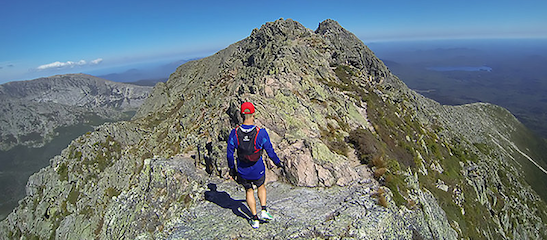
Mount Katahdin. Maine‘s highest peak at 5,269 feet (1,606 meters), serving as the crown jewel of the state’s wilderness landscape. Named “Katahdin,” meaning “Great Mountain” or “Greatest Mountain” by the Penobscot Native Americans, this granite monolith represents far more than just topographical prominence—it embodies the spiritual and cultural heritage of Indigenous peoples and serves as a beacon for outdoor enthusiasts from around the world.
Located in Northeast Piscataquis, Piscataquis County, within Baxter State Park, Mount Katahdin forms the centerpiece of one of Maine’s most pristine wilderness areas. The mountain lies approximately 20 miles northwest of Millinocket and consists of a group of summits with Baxter Peak serving as the highest point.
While Mount Katahdin reaches 5,269 feet, it stands more than 1,000 feet shorter than neighboring New Hampshire’s Mount Washington, which at 6,288 feet claims the distinction of being the Northeast’s highest peak.
However, Mount Katahdin’s isolation and wilderness character create a dramatically different experience from Mount Washington’s developed summit infrastructure. The mountain’s distinctive horseshoe shape encompasses five separate peaks: Howe Peak (with North Howe at 4,612 feet and South Howe at 4,734 feet), Hamlin Peak at 4,751 feet, Baxter Peak at 5,267 feet, South Peak, and Pamola Peak at 4,912 feet.
The mountain holds profound significance as the northern terminus of the Appalachian Trail, making it a pilgrimage destination for thousands of hikers who complete the 2,190-mile journey from Georgia to Maine.
This distinction transforms Mount Katahdin from a regional landmark into a nationally recognized symbol of endurance and achievement. The Appalachian Trail community regards reaching Baxter Peak as the ultimate accomplishment, marking the completion of one of America’s most challenging long-distance hiking experiences.
Geologically, Mount Katahdin presents a fascinating study in ancient granite formation. With its rocky peaks, sharp ridges, and boulder-filled slides, it towers over the surrounding forest as a granite giant. The mountain’s Knife Edge trail, connecting Pamola Peak to Baxter Peak, offers one of the most technically challenging and spectacular ridge walks in the northeastern U.S. This narrow granite ridge demands careful navigation and provides an adrenaline-inducing experience that attracts experienced hikers seeking adventure.
The cultural significance of Mount Katahdin extends beyond its physical prominence. The mountain is held sacred by the Maliseet, Micmac, and other Indigenous tribes, who have maintained spiritual connections to this landscape for thousands of years. This sacred status reflects the mountain’s role as a place of reverence, ceremony, and cultural continuity for Native American communities in the region.
Baxter State Park, established through the vision and generosity of Percival Baxter, serves as the protective stewardship framework for Mount Katahdin. The park’s “forever wild” mandate ensures that this wilderness remains preserved for future generations, maintaining the mountain’s ecological integrity and providing habitat for diverse wildlife species. The park’s management philosophy emphasizes conservation over development, creating a sanctuary where natural processes can continue undisturbed.
This approach contrasts sharply with Mount Washington’s accessibility via the Mount Washington Auto Road and cog railway, which make New Hampshire’s highest peak accessible to non-hikers. Mount Katahdin requires physical effort and hiking commitment to reach its summit, preserving its wilderness character and ensuring that visitors experience the mountain on its own terms.
Katahdin and nearby Hamlin Peak are the only two areas in Maine to host a subarctic climate and alpine vegetation, creating unique ecological conditions that support specialized plant communities typically found much farther north. This biological diversity makes the mountain a valuable research site for scientists studying climate adaptation and alpine ecosystems.
The mountain’s visibility extends far beyond its immediate surroundings. Katahdin offers some of the longest unbroken lines of sight in the United States, and on clear days can be seen from the White Mountains of New Hampshire, a distance of 170 miles.
This exceptional visibility creates a visual connection between Maine‘s highest peak and New Hampshire‘s Mount Washington, linking these two prominent northeastern summits across state boundaries. The reciprocal visibility between Mount Katahdin and Mount Washington represents one of the longest mountain-to-mountain sightlines in the eastern U.S., emphasizing both peaks’ dominance over the regional landscape.
Mount Katahdin continues to challenge and inspire visitors through its demanding trails, spectacular scenery, and profound cultural significance. Whether approached as a spiritual journey, athletic challenge, or natural science exploration, the mountain provides transformative experiences that connect people to Maine‘s wilderness heritage and the broader American outdoor tradition.